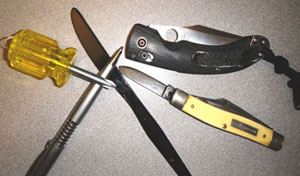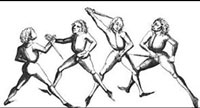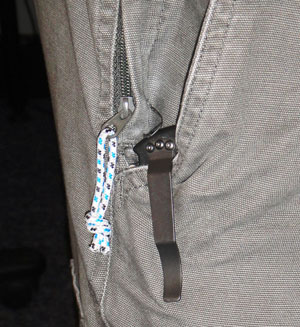I was recently asked why I’m so quick to recommend a knife, not a gun, as a primary personal-protection tool. For the purposes of this article, what I mean by a “knife” is one of the very commonplace folding knives found in almost any sporting goods store, or a small fixed-blade knife. Both of these may measure 6 to 7 inches total, with 2 to 3 inches of cutting surface. Here are some general reasons why I recommend a knife:
Knife vs. Gun for Self Defense
- Knives are easy to find and purchase
- Knives can be carried almost everywhere.
- Small knives are convenient to carry and conceal.
- More than one knife can be carried easily.
- A knife or object/improvised tool is possibly the most common tool found in our everyday environments — at work and at home.
- Local laws do not require a permit to own and carry a small knife.
- Knife applications can be easily adapted to improvised tools or nearly any firm pointed object.
- A small knife can be “palmed” or “indexed” covertly much more easily than a handgun, and a knife-like object or improvised pointed tool can be carried openly without drawing attention — for example, a pen or screwdriver
- A knife doesn’t require an in-depth understanding of ballistic overpenetration and clearing your background prior to application.
- Knives are easy to access and apply in confined spaces due to their small size.

At the time of writing this, these knives and knife-like items were in my immediate three-foot environment.
- Knives are easy to apply, requiring gross motor skills with minimal training time.
- Knives are easy to integrate with other physical defense skills.
- Knife application is not reliant upon size, strength or prolonged attribute training development. A child can put the tines of a fork against an adult’s leg and, with a little pressure, penetrate and retract, creating a wound. The child simply doesn’t understand the specifics of where, how and why.
- A knife can be a tremendous equalizer if utilized properly, more so than relying upon attribute-based physical defense skills such as punching or kicking. The latter need time to develop and size/mass to apply against an opponent of greater size/mass than oneself, or more than one opponent.
- A knife is better when facing an opponent with a knife, stick or even a gun (at close range) compared to relying upon just physical defense skills.
- A knife is an everyday tool that can be and is used for multiple utilitarian tasks, thus an almost instinctive familiarity with knives is ingrained in us from childhood. This same familiarity does not exist with a handgun. Give your wife or daughter a handgun and a steak knife off the dinner table and note which one they immediately recoil from.
- Under austere conditions or in unknown environments, a knife or knife-like tool can be more readily acquired or made.
A justified concern many have is their ability to apply the knife in a given situation. The knife is a close-contact tool that requires face-to-face application, similar to a hand-to-hand altercation. While many people have a hard time justifying the usage or application of such a tool to protect themselves, I urge you to consider that if your child, mother, father, brother or sister’s life is at stake, you must act.
This isn’t a knife “training” article per se, but in very general terms, knife application can be broken into three categories: point driven, edge driven, and a combination of both. Think about which method of application applies to the widest variety of knives, tools and objects, and analyze where and at what ranges each application can be utilized successfully. If robbery, rape, kidnapping or assault occurs at extreme close range, the ability to slash with the knife edge may be hindered. Consider the efficacy of edge-driven application (slashing) inside a car or when grounded in some type of grappling engagement.
Point-driven application applies to a broad spectrum of items, tools and objects found in our everyday environments and includes pens, pencils, forks, screwdrivers, and scissors. Point-driven application is predicated upon putting the point or tip of the knife or object between yourself and the attacker and thrusting, jabbing, or pushing at and into targets that provide maximum potential for preventing or stopping aggression against you.
The face (generic target), eyes (specific target), and throat area inflict decent physical damage while sending a clear psychological message. At extreme close range (contact distance), the “fork” (directly between the legs) is an easy to hit (large and somewhat fixed), vascular rich and psychologically intimidating target area. The torso is protected by bone (sternal plate and ribs) and muscle (abdominal musculature), and vital organs lie deep enough that thrusting and slashing require repeated penetration to inflict sufficient damage to stop an attacker, especially a young, strong and determined one.
Ultimately, the application method you choose is situation driven. If you have an actual knife, you may be able to slash and thrust. But if you’re in the front seat of your VW when a stranger gets in, and all you have is the plastic fork that came with your lunch, then knowing and understanding both methods may be essential to your survival.
Carrying, accessing and possibly utilizing a knife or knife-like tool on another person is serious business. It requires understanding the legal ramifications of doing so: the why, when and how of justifiable use of lethal force. If you carry and protect yourself and others with a knife, it is considered lethal force, just like a gun. A knife is an affordable option that is available nearly everywhere, legal in one form or another (do your research) nearly everywhere, and an extremely viable personal protection tool with minimal (a few weeks) training time. Personally, I would much rather have my family members’ EDC (everyday carry) be a convenient small folding knife as opposed to nothing at all.
If you’re not carrying a knife for self-defense, ask yourself why not. And if you are, keep in mind that possession does not equal proficiency, and learn the fundamentals of knife and edged-tool personal-protection skills.
Recommended Knife Training Programs/Systems
ShivWorks, Reverse Edge Method
AMOK
Kni-Com
CQB Services
Pekiti-Tirsia Kali


Pretty interesting read overall. Usually, I'm looking at knives more as a tool rather than actually self-defense weapon(like many others I'd assume). Maybe I should practice using it for defense a bit more and get comfortable with it!
I carry my Glock 19 daily and as backup I carry Ken Onion's CRKT Bearclaw in a leather sheath that I made for myself. It is smaller than the plastic sheath the knife comes with and has a smaller print. If I don't carry the Beatclaw, I carry my Leatherman Mini for greater versatility. But the Bearclaw is my primary backup. It is small and renders the bearer a very secure grip. It is also extremely sharp and as far as I am concerned, indestructible! I fully recommend this little monster for defensive carry.
I carry my Glock 19 daily and as backup I carry Ken Onion's CRKT Bearclaw in a leather sheath that I made for myself. It is smaller than the plastic sheath the knife comes with and has a smaller print. If I don't carry the Beatclaw, I carry my Leatherman Mini for greater versatility. But the Bearclaw is my primary backup. It is small and renders the bearer a very secure grip. It is also extremely sharp and as far as I am concerned, indestructible!
I took Kali training back in the 80's. With that training an advanced class was knife fighting utilizing kali skills. One thing most folks don't consider is no matter your skill set you are going to get cut. That said I am a strong advocate of knife use. As with any concealable weapon it must not be exposed until it can be used swiftly. Training is recommended. Just be prepared to take a cut if engaged in a knife fight. Great article.
I'm surprised that Martial Blade Concepts was not in your list of recommended knife training systems. I've trained in this system and have found both the content as well as the instructors excellent.
Interesting article. I had a lady talk to me about her young sister almost getting abducted at a rodeo/carnival. Seems that her sister could not confidently ID the perp and his co-workers misgivings about him could not result in an arrest. I have always advocated carrying at least 2 knives, and one of those is the 'skinning' type knife that utilized the scalpel blades. I have found that those blade break real easily with a good yank to the side, so even the smallest person would be able to employ and break one off inside an attacker. The surprise of this kind of response along with some judicial slashing might make an attacker retreat and try to get the blade out. this would be an ideal ID of the attacker if it were ever needed. Just an idea I had while contemplating the possible responses to use.
The beauty of carrying a knife is that it can be--and usually is--used for things other than combat. As a 20-year police veteran, I'm quick to tell rookies that you don't cut rope or open packages with a gun. . .
I carry two folders and at times a concealed straight edge. I have a conceal permit and it covers knives as well. I just have a basic understanding of knife combat. Would consider imprno.vin.g my skills. Thanks for your article. AJY
Why not a knife? Because it takes a lot more accuracy with a small knife to cut or stab something that is actually going to do enough damage to stop an attack. Broken bones from an impact weapon "MIGHT" be more effective pain compliance. I have read that there have been people that were not fatally wounded by either a cut or stab and they never knew that they had been cut or stabbed. Or even shot in some cases. I know there have been plenty of people killed with knives, but, were those knives bigger than a folding knife or a small sheath knife typically carried these days. I might be wrong about this and I do question my own reasoning. As I said, I would think a small blade would require a lot more skill.
Most of the links at the end either don't go to the intended site or don't really contain anything useful for someone who doesn't really want to train in a martial art.